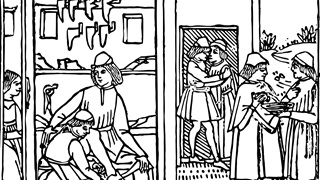
The Decameron
Jeffrey Anderson on Boccaccio’s celebration of life | Issue 18 | 2020


A meadow on the south bank of the River Thames. The fifteenth day of June in the seventeenth year of the reign of John, King of England, Lord of Ireland, Duke of Normandy and Aquitaine, and Count of Anjou. King John has just set his seal to a piece of parchment. It is still in draft but the document, when finalised and engrossed, will become one of the most famous documents in history: the Magna Carta.
The 800th anniversary of the sealing of the Magna Carta—on 15 June 1215—falls in 2015. What is it? Why was it produced? And what does it mean today?
When faced with a law or a statute, the first instinct of a lawyer is to go to the primary source. What does it actually say?
That is easier said than done with the Magna Carta. It is written in ink on parchment and, in order to compress it within the smallest possible space, it is written in a cramped style with no indentations. Even the clause numbers were inserted subsequently—rather like the act and scene divisions in the plays of Shakespeare.
The other problem—at least for most of us—is that it is written in Latin. So, in order to understand it better, we need to turn to an English translation which tries to capture the sense of the original whilst at the same time making it understandable to the modern reader. Of the four remaining copies of the Magna Carta, two are held by the British Library; and it has provided a very readable English translation, which it has divided into sixty-three clauses.
The first thing you notice, when you start to read the Magna Carta, is how little of it is relevant to us today. This is hardly surprising. It was a living document, speaking to the needs of those who produced it; and much of it is therefore concerned with issues which were very relevant eight hundred years ago, but of little significance now. Many of its clauses are concerned with the way in which the feudal system was to work. For instance, what was to happen when a landowner died, particularly if his heirs were still under-age—a not uncommon eventuality at the time.
To modern eyes, many of its provisions look very dated. The charter is addressed ‘To all free men of our kingdom’. Women are hardly mentioned; and, where they are, it is to limit their rights: ‘No-one shall be arrested or imprisoned on the appeal of a woman for the death of any person except her husband.’ But then, perhaps we need to read that in the light of the fact that it has taken another eight hundred years for the Church of England to admit women bishops.
As one might expect—this being England—class divisions were seen to be part of the natural order of things. ‘Heirs may be given in marriage, but not to someone of lower social standing.’ But again, a glance at the composition of the current British cabinet or judiciary shows the extent to which old habits die hard.
Some parts of the charter nevertheless seem very modern to a commercial lawyer. The following clause, for instance, contains the germ of the modern law of subrogation:
"If, for lack of means, the debtor is unable to discharge his debt, his sureties shall be answerable for it. If they so desire, they may have the debtor’s lands and rents until they have received satisfaction for the debt that they paid for him, unless the debtor can show that he has settled his obligations to them."
More fundamentally, there are parts of the charter which are as relevant today as they were eight hundred years ago. Perhaps the most important is clause 39:
"No free man shall be seized or imprisoned, or stripped of his rights or possessions, or outlawed or exiled, or deprived of his standing in any other way, nor will we proceed with force against him, or send others to do so, except by the lawful judgement of his equals or by the law of the land."
The rule of law applies to all, even to the King.
Other provisions also foreshadow later developments. Scutage (a form of taxation) cannot be levied in the kingdom without general consent. Royal prerogatives are limited—a royal official cannot take corn or other moveable goods from any man without immediate payment unless he agrees. Free movement is enshrined—any man may leave and return to the kingdom unharmed and without fear, by land or water.
The Magna Carta can only really be understood in context. And the context was war—both external (against the King of France) and internal (against the English barons). To a large extent, it was the cost of the former which led to the latter.
Shakespeare treated King John rather well—portraying him as a patriotic Englishman standing up to a foreign Pope. But, on the whole, King John has had a bad press; and there is little doubt that the barons did have legitimate grievances as a result of the King’s often inept attempts to extract more money from them.
But then, by all accounts, the barons were little better. They did not turn up at Runnymede to promote the rule of law, but to gain concessions for themselves.
After eight hundred years it is hard to be sure, but those who come best out of the whole affair seem to be the King’s advisers. They are mentioned by name in the preamble to the Magna Carta. Two stand out. Stephen Langton, the Archbishop of Canterbury, appears to have had a major role in converting a barons’ charter into a people’s charter (albeit only some of the people, and some of the time).
Perhaps the greatest of them all was William Marshal, the Earl of Pembroke and the Marshal of England. As a child, he was very nearly executed as a hostage for the treason of his father, but he survived. Starting off as a knight-errant, he became a general and adviser to four Angevin kings: Henry II, Richard I, John and Henry III. Not for nothing were the Angevins known as ‘the Devil’s Brood’, and what is particularly noteworthy about William’s involvement with them was his loyalty to the lawful monarch at the time—sometimes in the teeth of opposition from other members of the Brood. When Henry II was king, he supported Henry against the insurrection of his son Richard. When Richard became king, he served him. And when Richard died, he supported the next in line—his brother John.
Henry III was only nine when he became king on the death of his father, John; and William was appointed Regent of England, to rule on his behalf. In spite of spending much of his time fighting more revolting barons, William reissued the Magna Carta in 1216 and again in 1217; and this process of reiteration was repeated at various times throughout the succeeding centuries.
The importance of the Magna Carta is as much to do with perception as with reality. That is not unusual with historical events, particularly those which took place a long time ago.
Two things have kept the Magna Carta alive. The first is that, amongst all the provisions which were specific to the time, it gives written expression to two basic constitutional principles: the rule of law; and the prohibition on taxation without consent. These were not new ideas, even then, but what is important is that they were written down at a time when so much of the business of government was conducted by word of mouth.
Equally importantly, the written word was repeated—frequently. Almost as soon as the ink was dry, it was restated; and then again the following year, and from time to time over the succeeding centuries, so that it became part of the fabric of government.
When, in the seventeenth century, Parliament decided to take issue with King Charles I’s abuses of power, they started by issuing the Petition of Right in 1628. As well as describing what the King had done wrong, it expressly drew authority from statutes of Edward I which had restated the key principles enshrined in the Magna Carta.
It may have little direct bearing on modern life, but Magna Carta did set in motion a process which ultimately led to constitutional government.
Richard Calnan is a partner with Norton Rose Fulbright in London, Visiting Professor at UCL and an author with Oxford University Press. He writes on jurisprudence for RE.
© Norton Rose Fulbright LLP 2025